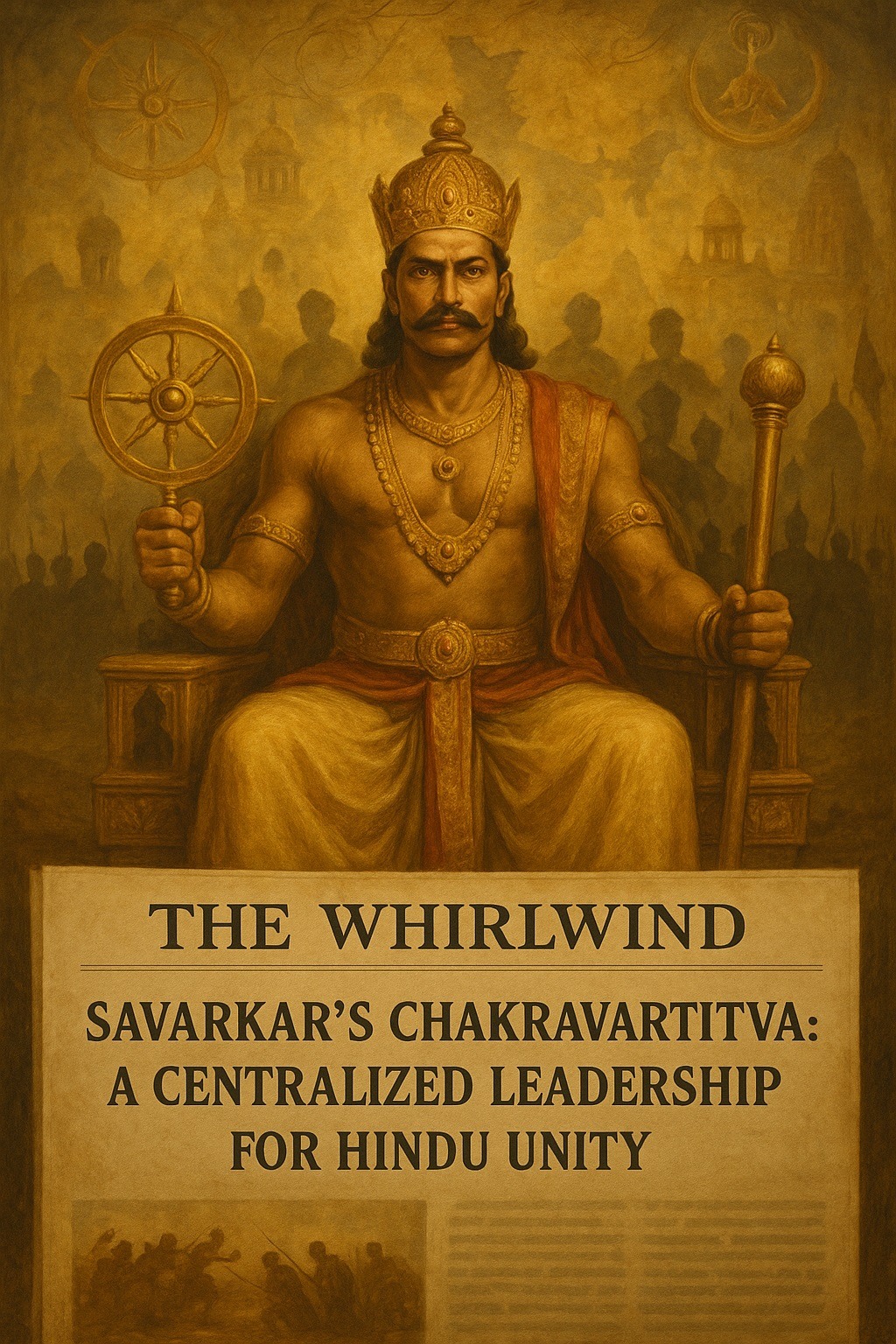Political Dimension of Hindutva, Part 7
Vinayak Damodar (Veer) Savarkar’s political-religious vision is deeply rooted in an archaic worldview. A key element in his concept of an ideal governance structure for Hindus is the idea of “Hindu leadership through a strong hand.” This theme is recurrent throughout his writings, particularly through his admiration of the institution of Chakravartitva and his belief in centralized power. The concept of a divine and political leader, a world conqueror, at the center of authority, is not a result of Savarkar’s metaphysical debates but rather draws from Asian scriptures that long predate him. These texts had already codified such ideas, which Savarkar then adapted to support his Hindutva ideology. He employs the Chakravartitva (literally “universal ruler”) as a historical model that ties back to ancient India’s martial ideals of world conquest.
For instance, Savarkar’s discussions about the need for a “counterattack” against Muslims incorporate the theory of Archaya Madhatithi, who called on Hindus to adopt an active, expansionist, and imperialistic policy. The rationale for this demand stems from constant threats posed by foreign forces hostile to Hinduism and the ineffective Hindu aristocracy of the time. According to Savarkar, Hindu princes were incapable of assuming political responsibility. They were either too self-interested or actively aligned with Hindu enemies, betraying nationalistic duties in favor of personal ambition. This inability necessitated the emergence of a “strong hand” to combat centrifugal forces within Hindu society and unify Hindus under one symbol, offering protection against external enemies.
The world to be conquered and defended was primarily the known Indian environment in the context of the time. In ancient times, internal conflicts and foreign invasions provided kings with opportunities to fulfill their mandates to both defend and conquer. Savarkar argues that this institution, the Chakravartitva, was not only justified but also sanctified by his ancestors.
The Chakravartin: The Ideal Hindu Leader
For Savarkar, the Chakravarti was an ideal Hindu leader who had subjugated all other Hindu kings. The title Chakravartin (“King of Kings” or Emperor) signified a ruler with supreme authority over all of India. The Chakravartin was seen as a conqueror of smaller states and the rightful ruler of the entire land. Despite its potential drawbacks and dangers, Savarkar viewed this institution as remarkably effective for Hindus. It served several key functions, including organizational and selection functions.
The organizational function helped create an institutional framework for nation-building, enabling Hindus to gradually form a political solidarity and unity within their national life. As a selection function, the Chakravartitva ensured that the best leader, organization, or people would emerge to guide the Hindu nation. It “forced” individuals of lesser ability to step aside for the more capable, preventing inefficiencies and national disadvantages. In Savarkar’s view, this ensured that the most competent and strongest individual took the helm during national crises.
The Natural Necessity of a Selection Process
Savarkar refers to this selection process as a “necessary evil”, essential for identifying the strongest leader. He acknowledges that under certain conditions, resistance from less capable individuals might foster the skills needed for leadership, contributing to the solidarity and political cohesion of Hindus. Essentially, Savarkar saw Hindu civil wars and internal struggles as competitive contests that tested the abilities of leaders. This competition, when faced with foreign threats, could reveal the most suitable candidate to defend the land and people. A Chakravartin was not merely a unifier of Hindu kings but also a conqueror of external powers, particularly non-Hindu forces hostile to the Hindu cause.
Chakravartitva’s Constitutive Role
The Chakravartitva institution’s role extended beyond its organizational and selection functions; it was deeply constitutive of the Hindu nation’s identity. According to Savarkar, if Hindus had developed a national consciousness or instinct, it was largely due to the great Hindu empires that were facilitated by this institution. Despite the shifting political center and the varying locations of the Chakravartin, this institution played a critical role in binding together the different provinces of India into a national framework. Savarkar draws an analogy to his interpretation of the “Aryan Migration Theory,” where he seeks to demonstrate a Here, as in his other work, Savarkar blended utopian ideals with historical realities, crafting a vision of Hindu unity and strength that served his broader political agenda. Shared, blood-based ancestry among Hindus, using historical empires as proof of this unity.
Final Thoughts – Chakravartitva in Savarkar’s Vision: Centralized Leadership for Hindu Unity
The institution of Chakravartitva serves as a symbol of centralized, strong leadership in Savarkar’s vision of a Hindu state. It is portrayed not only as a means of defending the Hindu nation but as a necessary and natural evolution in the political development of the Hindu people. Although Savarkar’s ideal of a “strong hand” has been criticized for its authoritarian overtones, it remains a central feature of his vision for Hindu unity and empowerment. By drawing on historical precedents and adapting them to his political ideology, Savarkar created a compelling narrative for the leadership of Hindus under a singular, powerful authority, advocating for the preservation and expansion of Hinduism through strategic governance and leadership. Ultimately, the institution of Chakravartitva in Savarkar’s vision was not just a model for political leadership; it was a symbol of Hindu resilience, a tool for unifying a fragmented society, and a means of asserting Hindu identity in a world of external threats and internal divisions.
How do you interpret Savarkar’s idea of the Chakravartin—as a historical symbol, a political necessity, or an authoritarian ideal? Do you think Savarkar’s admiration for centralized power reflects ancient Indian traditions, or was it a response to colonial and communal threats? What parallels can you see between Savarkar’s vision of a “strong hand” and other global ideas of leadership? Share your thoughts in the comments below!
Sources:
SAVARKAR, Vinayak Damodar. 1970. The Indian war of Independence 1857. Rajadhani Granthagar: New Delhi.
SAVARKAR, Vinayak Damodar. 1971. Six glorious (golden) epochs of Indian history. Savarkar Sadan: Bombay. 1971.


Leave a Reply